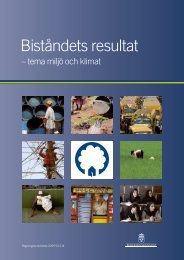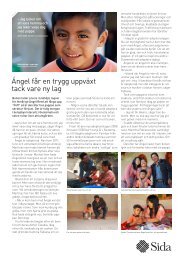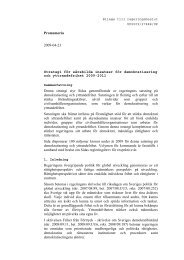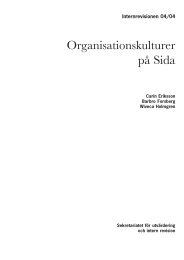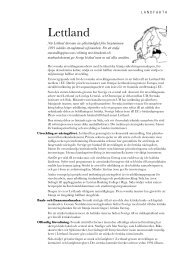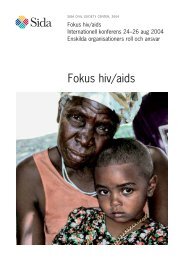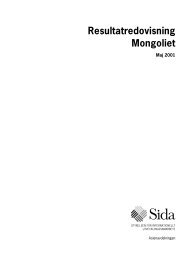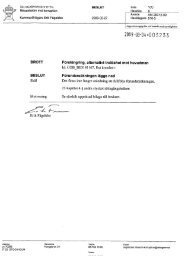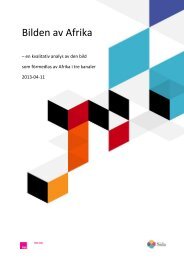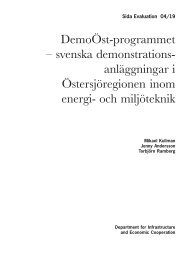Mid-Term Review of the AGIR Programme - Sida
Mid-Term Review of the AGIR Programme - Sida
Mid-Term Review of the AGIR Programme - Sida
You also want an ePaper? Increase the reach of your titles
YUMPU automatically turns print PDFs into web optimized ePapers that Google loves.
2 F I N D I N G S<br />
be relevant for <strong>the</strong> programme, being part <strong>of</strong> its scope <strong>of</strong> intervention, but its place in<br />
<strong>the</strong> results matrix might not be clear.<br />
The implementation <strong>of</strong> principles <strong>of</strong> good donorship in this area also poses dilemmas.<br />
For example, commenting on <strong>the</strong> previous version <strong>of</strong> this report, IBIS stated that under<br />
<strong>the</strong>se principles it is not <strong>the</strong> responsibility <strong>of</strong> <strong>the</strong> intermediary to define results<br />
and/or select activities <strong>of</strong> <strong>the</strong> partner organisations. This is evidently a risk for <strong>the</strong><br />
attainment <strong>of</strong> <strong>AGIR</strong>’s results, since partner organisations can choose activities that<br />
fall short <strong>of</strong> contributing to <strong>the</strong> programme results. Moreover, taking into account<br />
partners’ capacity problems, mainly in monitoring and evaluation, <strong>the</strong> ability <strong>of</strong> <strong>the</strong>se<br />
actors to select suitable activities is potentially limited. The consolidation <strong>of</strong> <strong>the</strong> practices<br />
<strong>of</strong> results-based management (RBM) in <strong>the</strong>se organisations, one <strong>of</strong> <strong>the</strong> results <strong>of</strong><br />
<strong>the</strong> programme, might potentially change this situation. It is also worth noting however,<br />
that <strong>the</strong> adoption <strong>of</strong> RBM by CSOs will be a result, per se, <strong>of</strong> <strong>the</strong> programme<br />
and it is not realistic to expect this to happen in time to influence <strong>the</strong> planning <strong>of</strong> o<strong>the</strong>r<br />
<strong>AGIR</strong> activities.<br />
Reporting has improved considerably, capturing only <strong>the</strong> set <strong>of</strong> activities that is relevant<br />
for programme results (including evidence/ indicators). This <strong>of</strong>ten helps link <strong>the</strong><br />
activities to specific results, but in practice <strong>the</strong>re are still many activities in <strong>the</strong> annual<br />
work plans that are relevant, because each fits into a specific area, but has a weak<br />
relationship to o<strong>the</strong>r undertaken activities. Most <strong>of</strong> <strong>the</strong> partners’ activities in <strong>the</strong> subprogramme<br />
<strong>the</strong>matic areas fit this description. There is a set <strong>of</strong> activities for joint<br />
monitoring through a joint results matrix. These activities comprise areas relevant to<br />
<strong>the</strong> programme objectives <strong>of</strong> streng<strong>the</strong>ning civil society (namely engagement with<br />
partners), capacity development, good donorship, networks and linkages, and mainstreaming<br />
<strong>of</strong> cross-cutting areas (gender, HIV/AIDS and human rights). Intermediaries<br />
are coordinating <strong>the</strong>ir approaches, sharing materials and even relying on <strong>the</strong> capacity<br />
<strong>of</strong> some partners to deliver training jointly. In <strong>the</strong>se common areas, <strong>the</strong> objectives<br />
are coherent across <strong>the</strong> sub-programmes. The initiative <strong>of</strong> <strong>the</strong> intermediaries to<br />
define a common baseline contributes to <strong>the</strong> streng<strong>the</strong>ning <strong>of</strong> a programmatic approach<br />
to <strong>the</strong>ir work.<br />
On <strong>the</strong> o<strong>the</strong>r hand, <strong>the</strong> specific sub-programme activities, apart from some subcomponents<br />
(for example, political accountability is common to <strong>the</strong> sub-programme<br />
managed by Diakonia and Oxfam Novib), are less integrated in <strong>the</strong> programme and<br />
stand as quasi-autonomous projects. As mentioned earlier in this report, even in jointreporting,<br />
<strong>the</strong> linkages among <strong>the</strong> <strong>the</strong>matic activities are <strong>of</strong>ten not clear. It should be<br />
acknowledged however, that through proper reporting (e.g. Oxfam Novib reports) and<br />
a focus on showing <strong>the</strong> linkages between activities, outputs and outcomes and an<br />
analysis <strong>of</strong> <strong>the</strong> results chains, <strong>the</strong> linkages would be clearer. This has been acknowledged<br />
by both intermediaries and partner organisations (in 2011), and through <strong>the</strong><br />
adoption <strong>of</strong> an ‘impact matrix’, <strong>the</strong> <strong>AGIR</strong> programme has improved <strong>the</strong> reporting in<br />
both 2012 plans and <strong>the</strong> recent <strong>AGIR</strong> 2012 semi-annual report.<br />
47




